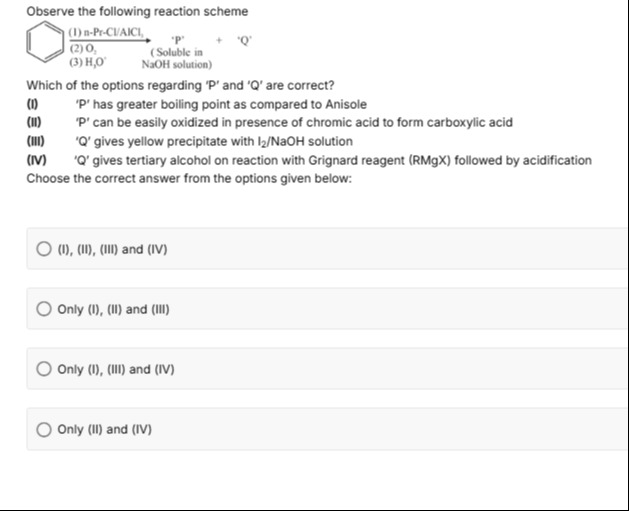Question
Question: Observe the following reaction scheme Which of the options regarding 'P' and 'Q' are correct? (I) '...
Observe the following reaction scheme
Which of the options regarding 'P' and 'Q' are correct? (I) 'P' has greater boiling point as compared to Anisole (II) 'P' can be easily oxidized in presence of chromic acid to form carboxylic acid (III) 'Q' gives yellow precipitate with I2/NaOH solution (IV) 'Q' gives tertiary alcohol on reaction with Grignard reagent (RMgX) followed by acidification Choose the correct answer from the options given below:

Only (I) and (II)
Only (I), (II) and (III)
Only (I), (III) and (IV)
Only (II), (III) and (IV)
Only (I), (III) and (IV)
Solution
The reaction scheme describes the conversion of benzene through a series of steps involving n-propyl chloride and aluminum chloride, followed by oxidation with oxygen and hydrolysis.
Step 1: Friedel-Crafts Alkylation Benzene reacts with n-propyl chloride in the presence of a Lewis acid catalyst like AlCl3. This is a Friedel-Crafts alkylation reaction. Due to the potential for carbocation rearrangement, n-propyl chloride (CH3CH2CH2Cl) primarily forms a secondary carbocation (CH3CH+CH3) which is more stable than the primary carbocation. Therefore, the major product is isopropylbenzene (cumene), along with a minor amount of n-propylbenzene.
Benzene+n-Pr-ClAlCl3Isopropylbenzene (major)+n-propylbenzene (minor)
Step 2 & 3: Oxidation and Hydrolysis (Cumene Process) The subsequent steps involve oxidation with oxygen (O2) and then hydrolysis with water (H2O). This sequence is characteristic of the cumene process for the production of phenol and acetone from isopropylbenzene. Isopropylbenzene is first oxidized to cumene hydroperoxide. Isopropylbenzene+O2→Cumene hydroperoxide Cumene hydroperoxide is then hydrolyzed, typically in the presence of an acid catalyst, to yield phenol and acetone. Cumene hydroperoxideH2O, H+Phenol+Acetone
The problem states that 'P' is soluble in NaOH solution. Phenol is acidic and dissolves in aqueous NaOH solution, while acetone (a ketone) is neutral and does not dissolve in NaOH. Therefore, we identify 'P' as Phenol and 'Q' as Acetone.
Let's evaluate each statement:
(I) 'P' has greater boiling point as compared to Anisole 'P' is Phenol. The boiling point of phenol is 181.7 °C. Anisole (C6H5OCH3) has a boiling point of 154 °C. Phenol can form intermolecular hydrogen bonds due to the -OH group, leading to a higher boiling point compared to anisole, which is an ether and cannot form such hydrogen bonds. Thus, statement (I) is correct.
(II) 'P' can be easily oxidized in presence of chromic acid to form carboxylic acid 'P' is Phenol. Phenol is generally resistant to oxidation by chromic acid to form a carboxylic acid. Strong oxidation of phenol typically leads to quinones (e.g., p-benzoquinone). Therefore, statement (II) is incorrect.
(III) 'Q' gives yellow precipitate with I2/NaOH solution 'Q' is Acetone (CH3COCH3). Acetone is a methyl ketone. Methyl ketones react with iodine in the presence of a base (like NaOH) in the iodoform test, producing a yellow precipitate of iodoform (CHI3). CH3COCH3+3I2+4NaOH→CHI3↓+CH3COONa+3NaI+3H2O Thus, statement (III) is correct.
(IV) 'Q' gives tertiary alcohol on reaction with Grignard reagent (RMgX) followed by acidification 'Q' is Acetone, which is a ketone. Ketones react with Grignard reagents (RMgX) followed by acidic workup to yield tertiary alcohols. CH3COCH3+RMgXetherIntermediateH3O+R-C(CH3)2-OH The product is a tertiary alcohol. Thus, statement (IV) is correct.
The correct statements are (I), (III), and (IV).
